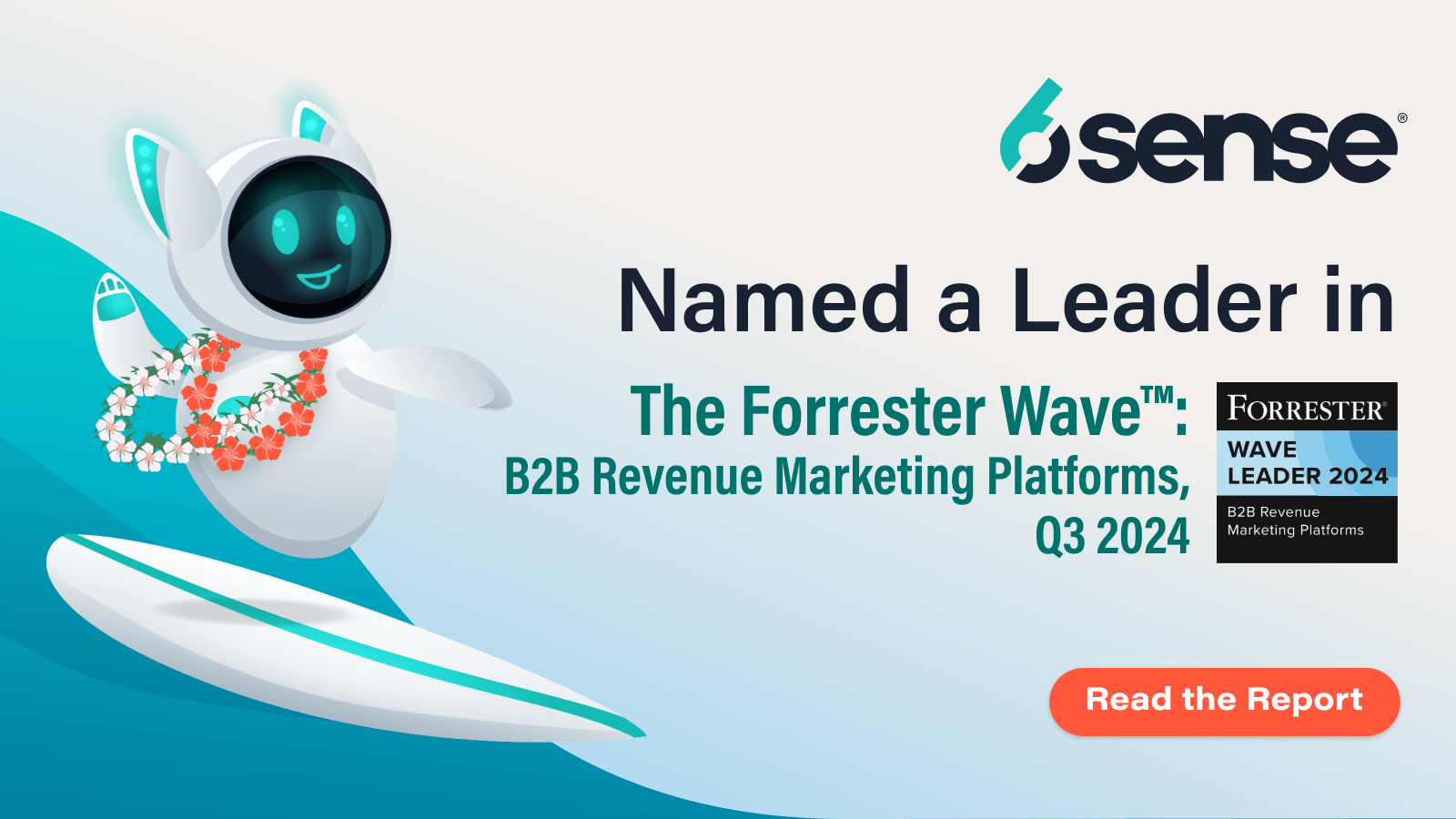We’re going to put it bluntly: a lot of common B2B marketing metrics are BS.
Sure, they tell you something about how someone engaged with a piece of content. But the devil is in the lack of details.
Marketing teams that use sophisticated intent data and AI-powered insights are better equipped to:
- Find the right members of a buying team,
- Understand what topics those individuals are most interested in
- Retarget them with content that will strike the right chord.
Take a look at these next gen marketing metrics that uncover deeper insights about your buyers and reveal your team’s actual impact on revenue.
Consider These Next Gen Marketing Metrics Instead
Impressions → Reach
Impressions track how many times an ad or social media post was displayed. But it doesn’t mean it was seen, or if it was seen by the right person at a company within your ideal customer profile (ICP).
Instead, measure reach: the number of unique people in your target audience who are exposed to your campaigns.
Click-Through Rate → View-Through Rate
Click-through rates tell you just that: the percentage of people who saw your ad and clicked on it. What can you do with this information? Not a whole lot.
You’re missing a bunch of other critical details, like:
- Why they clicked
- Their other activities online
- Whether they’re part of the buying team
In fact, this person could be someone totally out of your target audience simply looking for more information about a certain topic. On the other hand, there may be buyers from your target accounts who view the ad but never click on it. Click-through rates actually bring up more questions than answers.
View-through rates take this engagement a layer deeper, providing insight into how a particular ad or piece of content influences people to take further action. A view-through rate measures how many people convert on your website after viewing an ad, but not necessarily clicking on it.
When you pair view-through information with 6sense’s ability to de-anonymize accounts and capture intent data, you get a detailed picture of how your advertising efforts are influencing the buying journey of target accounts.
Cost Per Click → Cost Per Result
Clicks don’t indicate a person is ready to buy from you, which makes cost per click also a rather arbitrary measurement of success. A low cost per click may look great on paper, but what does it mean for business outcomes? Did those clicks lead to revenue, or at least deep engagement from target accounts? If the answer is “no,” or “I don’t know,” this value is virtually meaningless.
Cost per result is more specific and flexible, as you can determine the desired “result,” or outcome — which could be researching a keyword the contact was targeted with, visiting your website, consuming website content related to a keyword, or booking a demo. This enables your marketing to be more strategic by allocating resources and budget toward specific actions.
Clicks → Number of Accounts Engaged
Not all clicks are created equal. Some are unintentional. Some come from wildly unqualified leads. And some come from click farms devoted to defrauding advertisers.
Instead of counting clicks, look at engagement. After accounts see your campaigns, how many begin doing research?
Measuring account engagement relies on buyer intent data that can be tied to specific accounts — the data 6sense provides. The platform can also track how accounts interact with your various campaigns, your website content, and third-party content. That enables you to spot when account behavior shifts, and tie together the factors that influenced the buying journey.
MQLs → In-Market Accounts
Marketing-qualified leads, or MQLs, refer to people who have engaged with marketing content and are considered ready to be engaged by sales. The definition of an MQL differs from one organization to the next, and what qualifies someone as an MQL is usually based on hunches rather than data.
The truth is, people engage with content for a number of reasons, like:
- Looking for statistics
- Doing preliminary research
- Trying to contact a company about something irrelevant to sales
So, just because someone downloaded an ebook or clicked on an ad, it doesn’t mean you should start blasting them with follow-up emails or phone calls.
“In-market” is a term used to describe accounts that match an ideal customer profile and are actively showing buying signals. Whereas MQLs focus on the actions of a single person, measuring at an account level enables you to strategically engage multiple members of the buying team to move a deal forward. This is critically important, because research shows many different stakeholders are part of buying teams. If you can get multiple buying team members engaged, you can dramatically increase your chances of landing a deal.
SQLs → 6QAs
Sales-qualified leads, or SQLs, refer to leads that have been determined to be legitimate opportunities. Just like MQLs, what makes an account an SQL is entirely subjective.
6QAs (6sense qualified accounts) is a 6sense-developed metric that marks when an account is approaching a purchase decision based on buyers’ activity, the number of buying team members who are engaged at the target account, and historical information about your past deals
When multiple members of the same team are researching your brand, that sends a huge signal that the team is serious about purchasing a solution. And with this signal, you’ve got the green light to begin further conversations and outreach with those buyers.
Pipeline Attribution → Conversion of Accounts to Pipeline and Revenue
Digital marketers strive to attribute leads to specific marketing channels. But today’s B2B sales and buying cycles can take months and involve dozens of touchpoints. Trying to attribute a contact to a single marketing channel can be a fool’s errand — and a giant waste of your time.
By understanding how your campaigns are influencing customers throughout their buying journey, you can see which campaigns are nudging them forward along the path toward revenue. This allows you to maintain a broader picture of which efforts are and aren’t working, rather than attributing most of the success to just the first or final touchpoint.
Conversion Rate → Account Engagement Score
Conversion rate is simple: How many people interacted with your marketing content, and what percentage then became a customer.
But it lacks the nuance that could help you win more customers.
The Account Engagement Score takes a look at account behavior and how closely an account’s behavior matches past, A score between one and 100 is assigned telling marketing and sales how engaged that account is, based on research, website visits, clicks, keywords researched, and videos played. The higher the score, the higher likelihood that the account is ready to buy, so it’s time to target them with more content or pick up the phone.
Page Views → Relevant Content Consumed
Just because a person visits a page on your website, it doesn’t mean they are ready to buy — or even hear — from you. They might be starting their research, plan to use information on your site for something else, or simply feeding curiosity. Without understanding what other activities they’re doing online, it’s not fair to make assumptions and start bombarding them with outreach.
So, look at relevant content consumed instead. Perhaps the buyer viewed a page on your website related to a specific product, then performed a keyword search related to that product, and browsed competitor products. These behaviors suggest more than a passing interest and tell you that this buyer may be ready for a deeper conversation.
Contacts Reached → Buying Team Engagement
Besides a contact’s email, name, and location, what do you know about them? Do they work for a company on your target account list, or are they a poor fit for your offerings. Are they a key decision maker on the buying team, or an intern?
Account intelligence tools like 6sense provide clues that uncover buyer personas and help you identify contacts. Once you know that a target account has a buying persona engaged, you can quickly purchase contact information for other buying team members, then target each person with hyper-relevant content for their role.
Number of Leads Processed → Account Velocity Through Buying Stages
Rather than counting leads, count accounts and watch how closely in-market accounts progress through buying stages. Account velocity is an indicator of pipeline health, and measures how quickly you convert opportunities into revenue.
If moving accounts through the sales process is a slog, and getting them from one stage to the next requires much effort, you may not be finding the right buyers for your solution. Or, it could mean there are steps in the process that are inefficient and leave buyers looking for other solutions.
Faster velocity through the buying journey lets you know that you are delivering a valuable customer experience for accounts that are considering buying from you. The more value you can provide accounts at every stage, the more you’ll win.
Conclusion
Without technology, analyzing these next gen metrics is next to impossible. It’s time for marketing teams to become more sophisticated in the data they gather, the way they gather it, and the way they use it to propel engagement with the right buyers.
Discover more ways to elevate your marketing by checking out version 2.0 of 6sense CMO Latane Conant’s updated book, “No Forms. No Spam. No Cold Calls,” written just for B2B marketers.



